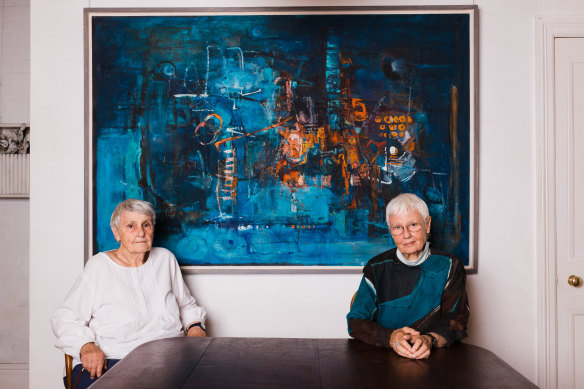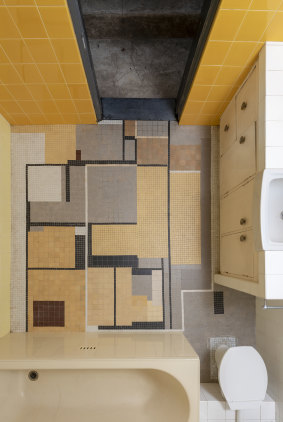- Exclusive
- Culture
- Art & design
- Exhibitions
This was published 1 year ago
Meet the woman who brought Bauhaus to Australia
By Helen Pitt
Margo Lewers, the interior designer and abstract artist credited with introducing Bauhaus concepts to Australia in the 1930s and ’40s, loved colour and lived a colourful life – including transforming her house into a Bohemian paradise that was regularly frequented by high-profile artists, such as author Patrick White.
Despite having no formal art qualifications when she left school, in 1935 she began a thriving business decorating hand-made ceramics, printing textiles, and then producing furniture through her shop Notanda Gallery, in Rowe Street, once Sydney’s design Mecca.
From this week Penrith Regional Gallery, home of The Lewers Bequest, will host an exhibition of the art and life of Margo Lewers (1908–1978), and launch a book No Limits, with insights from her daughters on the story of one of the nation’s best 20th century Modernist artists.
When Lewers and her sculptor husband Gerald Lewers moved from Cremorne to Emu Plains in 1952, to have more space to create art they became known as “the bohemians on the river”.
“When our parents moved to Emu Plains, they didn’t have any furniture,” her daughter jeweller Darani Lewers recalls.
“Margo decided instead of having furniture she would use colour, so she painted every single slat on the Venetian blinds a slightly different tone, she would dye the carpets and pillow slips so that the whole house was a celebration of colour.”

Margo Lewers’ daughters Tanya Crothers and Darani Lewers with one of their mother’s paintings.Credit: James Brickwood
Paintings were hung in the kitchen, prints covered the walls in the bathroom, which their mother tiled herself in a Mondrian-like mosaic in shades of greys, creams, and biscuit-beige in geometric shapes like the Modernist master.
Over decades, Margo transformed an old pig farm on the banks of the Nepean River into a vibrant garden resembling a colourful abstract painting and creative hub, where “ideas hurtled, argument flared, voices shouted, sparks flew,” as author Patrick White, a regular guest, wrote.
Another artistic friend and regular visitor, Judy Cassab, painted a portrait of her friend Margo which won the 1967 Archibald Prize.

Margo Lewers’ Mondrian-inspired mosaic tiled bathroom.
Darani Lewers and her sister Tanya Crothers, now both in their 80s, donated their colourful western Sydney family home, including Ancher House (commissioned for Margo’s mother by Modernist architect Sidney Ancher) to the public, after their mother’s death in 1978.
A House Full of Paintings includes paintings, collages, mosaics, fabric hangings, and plexiglass sculptures, set amidst her original homestead and heritage garden. Also included is a never-before-seen collection of collages, as well as her hand-made Christmas cards and documentation of her mosaics.
When her husband was killed in 1962 by a fall from a horse, Margo completed two of his commissions, the giant copper sculpture for The Reserve Bank in Canberra and the Gosford War Memorial Fountain.
Expansion, her nearly 14 metre-long mosaic at Canberra’s Rex Hotel, was the talk of the town when she completed it in 1960, and typified the colourful mosaics she forged throughout her home.
It is a house and garden as colourful as Claude Monet’s Giverny in France, or Frida Kahlo’s Blue House in Mexico City, with the difference that as the site of Penrith Regional Gallery, it is not just a home of a former artist that is now a museum, her architect daughter Tanya Crothers said.
“Margo wanted the house to continue to be a place of creativity for people to use it as a place where art was made.
“It’s living modernism... certainly our parents’ home, garden, their social and cultural life was very much central to the origins of the way Sydney modernism evolved. Abstract expressionism heralded a new phase in art where anything was possible, and they lived through the period that made that possible.”
The exhibition runs until May 14 at Penrith Regional Gallery.
A cultural guide to going out and loving your city. Sign up to our Culture Fix newsletter here.